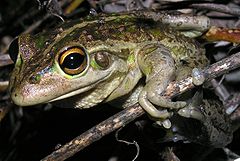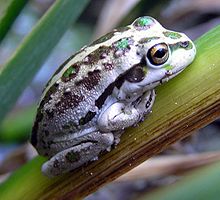- Litoria moorei
-
Litoria moorei Conservation status Scientific classification Kingdom: Animalia Phylum: Chordata Class: Amphibia Order: Anura Family: Hylidae Genus: Litoria Species: L. moorei Binomial name Litoria moorei
Copland, 1957Distribution of Litoria moorei Litoria moorei is a frog well known in Southwest Australia, its notoriety deriving from the call suggestive of a common name, the Motorbike Frog. It is a ground dwelling tree frog of the Hylidae family, one of only three species of Hylids occurring in that region. One common name comes from the male frog's mating call which sounds similar to a motorbike changing up through gears; it is also known as Moore's Frog, the Western Bell Frog, the Western Green and Golden Bell Frog, and the Western Green Tree Frog.
Contents
Physical description
Litoria moorei is able to camouflage itself well, and ranges in colour from dark brown, through to green and gold. The underside is noticeably lighter, and usually ranges from very pale green to light brown. The light green of the groin and thigh distinguishes this species from its cogenor, Litoria cyclorhyncha, which is darker and spotted with yellow there. Typical of tree frogs, it has toe pads which enable it to climb smooth vertical surfaces. Its hind legs are powerful, and the toes are webbed. In mating season the male develop black nuptial pads that enable it to cling to the female’s back during amplexus.
The tadpole's body is a uniform dark brown above with a silvery sheen below, initially minute in size, they grow to a very large 80 mm in length. The tadpoles usually hide amongst vegetation, but are easily encouraged out of hiding when food is presented. For most of their time as tadpoles, they often crowd together in schools.
Ecology and behaviour
 Litoria moorei calling in a residential garden in Swanbourne, Western Australia
Litoria moorei calling in a residential garden in Swanbourne, Western Australia
Breeding season is from early spring through to late summer. The male's mating call sounds like a motorbike changing gear. The males usually find a suitable clump of reeds or other water plants, from which to call. When a female joins the male in the water, the male grips onto the female’s back, using his nuptial pads, that appear during breeding season. Large clumps of eggs, encased in a transparent jelly, are attached to floating vegetation and debris.
Despite being a tree frog, Litoria moorei seldom climbs higher than one or two meters, on plants, shrubs, brick walls or windows.
Diet consists mainly of arthropods, but also includes smaller frogs, including juveniles of the same species. The tadpole's main diet is algae, but they will also eat meat when available. Tadpoles, like adult frogs, sunbathe for one or two hours each day for healthy growth.
A wide and populous distribution through lakes and swamps has readily incorporated garden ponds and farm dams where they are often found sunbathing on the upper leaves of plants. They can live without water for extended periods of time.
Litoria moorei is a member of the Litoria aurea complex. Unlike the eastern members of the complex (Litoria aurea, L. raniformis and L. castanea) the Motorbike Frog has not suffered from dramatic declines, despite chytrid fungus being present in areas which they inhabit.
Distribution
Port Gregory north of Geraldton, to the Albany region, and inland to the western wheatbelt. Also quite common in the Perth region, particularly in the Swan Coastal Plain. The species is one of the most well known amphibians of Western Australia. They are the most common frog to be found in Perth gardens.
References
- Barker, J.; Grigg, G.C. & Tyler, M.J. (1995). A Field Guide to Australian Frogs. Surrey Beatty & Sons. ISBN 0-949324-61-2.
- "Amphibian Species of the World - Litoria moorei (Copland, 1957)". http://research.amnh.org/herpetology/amphibia/references.php?id=13583. Retrieved 2006-08-28.
- "Frogs of Australia > Litoria moorei / Motorbike Frog". http://frogs.org.au/frogs/species/Litoria/moorei. Retrieved 2006-08-28.
External links
 Media related to Litoria moorei at Wikimedia Commons
Media related to Litoria moorei at Wikimedia Commons  Data related to Litoria moorei at WikispeciesCategories:
Data related to Litoria moorei at WikispeciesCategories:- IUCN Red List least concern species
- Litoria
- Amphibians of Western Australia
Wikimedia Foundation. 2010.




